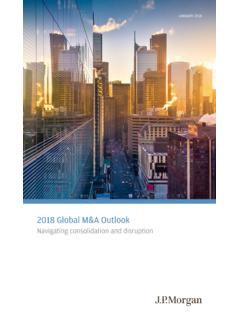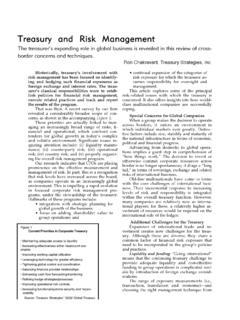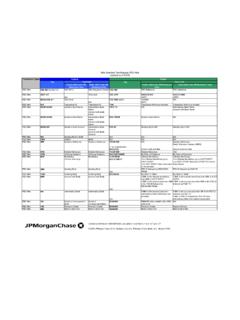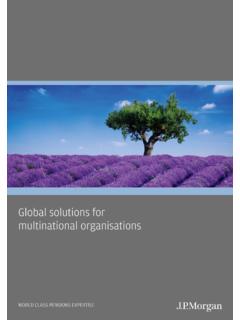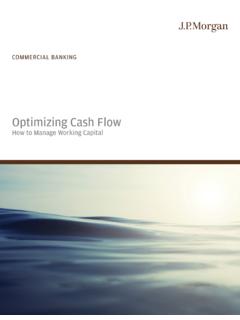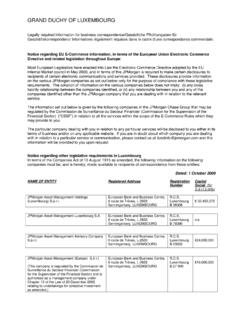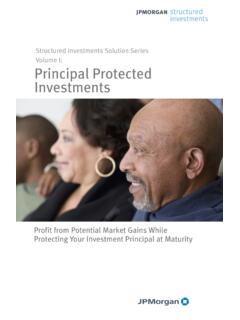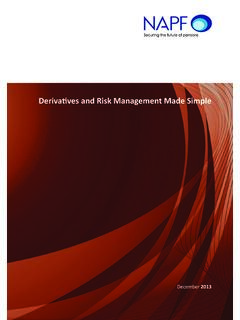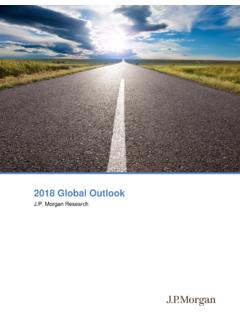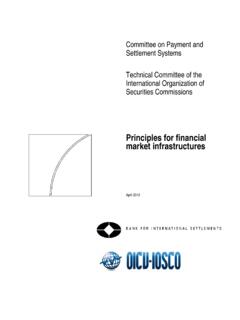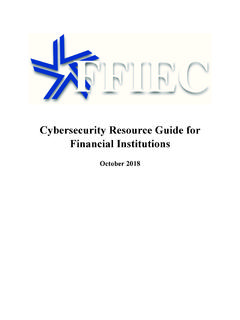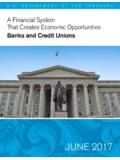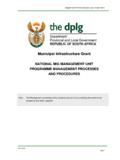Transcription of Core nfrastructure’s ron roe n nsttutona ortfoos
1 The infrastructure momentCore infrastructure s growing role in institutional portfoliosJanuary 2017 AUTHORSS erkan Bah eci, PhD Head of Infrastructure ResearchStephen Leh Infrastructure ResearchIN BRIEF As a new asset class, infrastructure has proved itself over the last decade, establishing a strong track record that highlights its potential to enhance returns and mitigate risk as part of a broader portfolio. Furthermore, the expected total return for private infrastructure is now greater than the expected total return of a 60/40 portfolio, with income also representing a substantial component of the return from In this paper we explore how private core infrastructure provides investors with the D-I-Y benefits of diversification, inflation protection and yield along with a strong focus on environmental, social and governance (ESG) principles.
2 We also examine recent trends in valuations, discuss options for accessing infrastructure investments, and explain why with institutional investors average allocations still below target the expansion of the asset class continues to provide opportunities for early APPEAL OF core INFRASTRUCTURE Institutional investors have been allocating a growing share of their portfolios to infrastructure assets including regulated utilities, transportation and contracted power. The focus has been on core investment strategies, which can produce stable, forecastable cash flows through the use of prudent leverage and some combination of transparent and consistent regulatory environments, long-term contracts with credible counterparties, and mature demand profiles. Most core infrastructure assets have monopolistic positions in the markets they serve, so prices and usage are relatively insensitive to periods of economic weakness.
3 Instead, core infrastructure investments are driven by a different and uncorrelated set of factors, including political and regulatory risk, development risk, operational risk and leverage. Also, each core infrastructure sector has unique risk factors, so core strategies include investments from multiple sectors to reduce volatility within the asset class. 1 Morgan Asset Management, 2017 Long-Term Capital Market Assumptions, 21st Annual INFRASTRUCTURE MOMENT2 INVESTMENT INSIGHTSIn today s challenging everything is expensive investment environment, with Barclays Aggregate yields well below their long-term averages and the S&P 500 s price-to-earnings ratio above 20 (as of 7 December 2016), investors are increasingly turning to private core infrastructure for its D-I-Y benefits: (D) = diversification and low correlation to other asset classes (I) = inflation protection (Y) = yield with high and stable cash flowsDIVERSIFICATION.
4 INFRASTRUCTURE CAN HELP TO REDUCE PORTFOLIO VOLATILITYA key benefit of core infrastructure investments is their ability to provide relatively high total returns with low correlations to traditional asset classes, such as equities, fixed income and real estate. Consequently, an allocation to core infrastructure may reduce the volatility of an institutional portfolio and can potentially limit the maximum drawdown during times of market stress. Many core infrastructure assets are natural monopolies by design. For some assets, such as regulated utilities, alternative providers are forbidden by the government. For others, such as transportation assets, alternative routes are often distant and time-consuming. The monopolistic position of these assets makes the demand for their services resilient to economic downturns and fluctuating prices.
5 core infrastructure assets also utilise long-term contracts. Power generation assets can protect themselves from volatile power markets through long-term contracts with utilities, corporates or governments. The contracts, which can last as long as 30 years, establish very stable cash flows in return for the asset s availability and generation. Since core infrastructure investments have reduced exposure to market demand, their risk-return drivers are relatively uncorrelated with other asset classes (see Exhibit 1).INFLATION: INFRASTRUCTURE CAN HELP TO PROTECT AGAINST RISING PRICESAn unexpected rise in inflation can be very costly to investors, so portfolios with a long-term focus should protect against rising prices even in low-inflation environments. This is particularly relevant today, as expectations for fiscal stimulus in the US, the post-Brexit depreciation of sterling, and a partial recovery in the price of oil have increased the likelihood that inflation could overshoot central banks target levels.
6 Infrastructure investments especially utilities and transport assets can provide investors with protection when inflation unexpectedly rises. In many jurisdictions, particularly in Europe, end-user rates for regulated utilities are indexed to inflation. Where automatic adjustment does not exist, utilities can typically file new rate cases when their costs rise. Regulators have also allowed utilities to earn a greater return when inflation has been higher. Exhibit 2 illustrates the positive correlation between inflation and the allowed return on equity (RoE) of US electric utilities, with a two-year lag to account for regulatory adjustment periods. core infrastructure return drivers differ from those of other asset classesEXHIBIT 1: ASSET CLASS CORRELATIONS2008-2015 Global equitiesGlobal bondsUS core private real estatePrivate equityHedge fundsGlobal listed infrastructureGlobal core private infrastructureGlobal core private real listed core private : Bloomberg, MSCI World Index for global equities, Barclays Global Aggregate Bond Index for global fixed income, NFI-ODCE for core private real estate.
7 Burgiss for private equity, HFRI for hedge funds, S&P Global Infrastructure Index for global listed infrastructure, and MSCI Global Quarterly Infrastructure Asset Index for global core private Data are quarterly from Q2-2008 through Q4-2015 (the full available range for the MSCI Infrastructure Index), and are denominated in local currency. Data as of December The MSCI Quarterly Infrastructure Asset Index is the first third-party return index in the private infrastructure space. It has a relatively small sample and a bias towards Australian assets, but it continues to evolve and is a good indicator of infrastructure INFRASTRUCTURE MORGAN ASSET MANAGEMENT 3 Revenues derived from transportation assets also tend to have strong inflation sensitivities. This is because revenues in the sector largely come from bilateral contracts with third parties, such as airlines and shipping lines, and these contracts typically include some form of inflation indexation.
8 While inflation tracking is also common in power contracts across the developed world, the US is a prominent exception. YIELD: INFRASTRUCTURE CAN PROVIDE HIGH AND STABLE CASH FLOWSCore infrastructure s strong yield potential is a major reason why institutional investors are attracted to the asset class in today s low-yield environment. Yields on core infrastructure investments have been remarkably resilient, as forecastable cash flows, long economic lives and creditworthy counterparties have bolstered asset-level cash flows. Exhibit 3 shows how infrastructure s stable yield has mitigated the fluctuations in value from capital appreciation. This was especially true during the global financial crisis of 2008/2009, when steady income helped insulate infrastructure investments from the stress in capital markets.
9 Infrastructure s year-over-year total return was negative for only a single quarter, and the asset class cumulative decline never topped 2%. INFRASTRUCTURE VALUES ARE INCREASING Since the recovery from the financial crisis took hold in 2009/2010, valuation discount rates for core infrastructure assets have generally trended downwards. This is due, in part, to the broader decline in interest rates, which has caused all asset classes to look more attractive on a relative basis. Exhibit 4 shows how the estimated discount rate for core infrastructure assets has decreased alongside government bond yields, keeping the equity risk premium relatively RoE for US electric utilities has had a positive correlation to inflation over timeEXHIBIT 2: INFLATION VS. ALLOWED ROE FOR US ELECTRIC UTILITIESy = + = , year-on-year percentage changeAllowed RoE (%)Source: Bloomberg, , America s Electric Utilities, Morgan Asset Management.
10 Inflation=US consumer price index data from 1968 to 2013. Electric utility RoE data from 1970 to 2015. Data as of September stable yield has helped to mitigate fluctuations in capital value through changing marketsEXHIBIT 3: UNLISTED INFRASTRUCTURE RETURN FROM INCOME AND CAPITAL APPRECIATION-10%-5%0%5%10%15%20092010201 12012201320142015 Return from incomeReturn from capital appreciationSource: MSCI Global Quarterly Infrastructure Asset Index, Morgan Asset Management. Data show rolling one-year returns from income and represent the index s full available timeline, from Q1-2009 onwards. Data as of December INFRASTRUCTURE MOMENT4 INVESTMENT INSIGHTSI nfrastructure valuations have generally become more attractive as interest rates have fallenEXHIBIT 4: ESTIMATES FOR core INFRASTRUCTURE DISCOUNT RATES VS.
